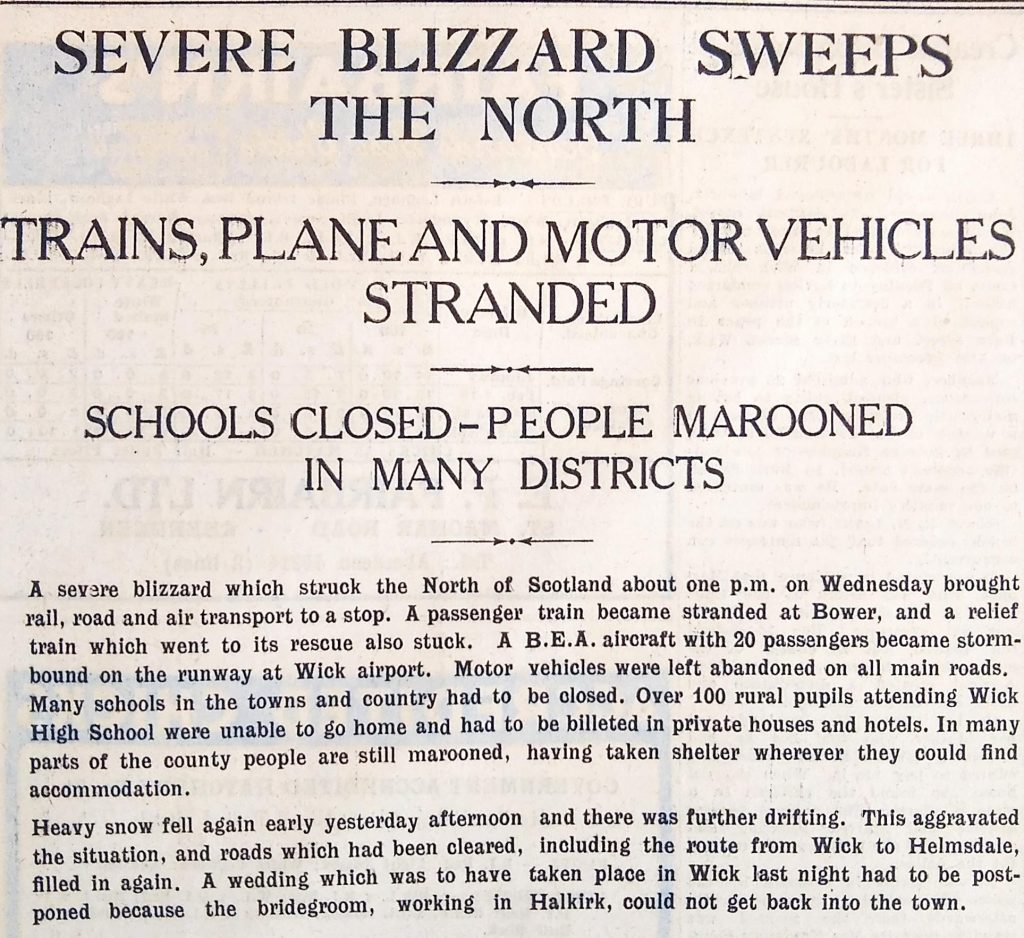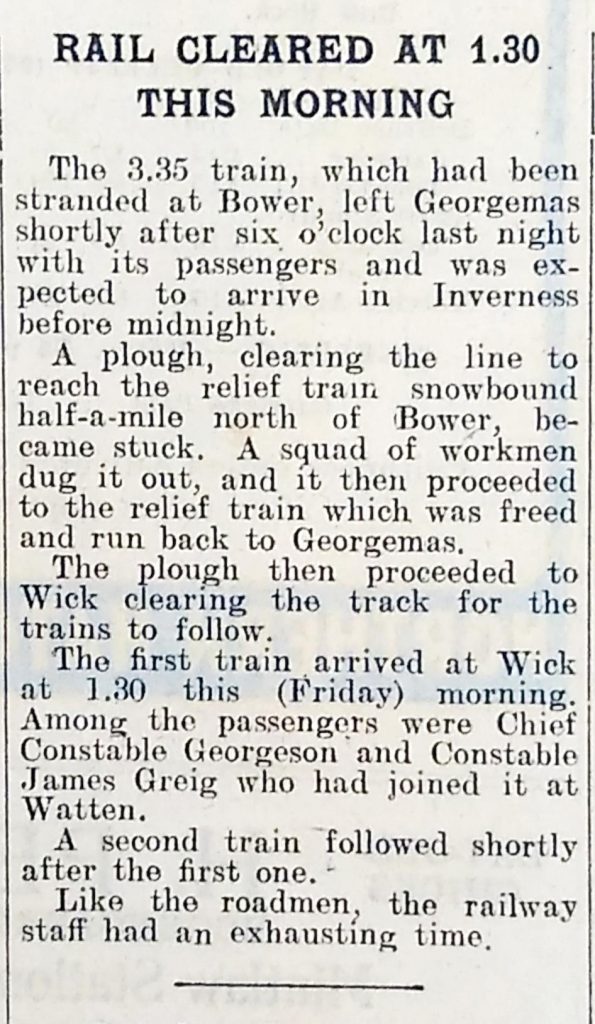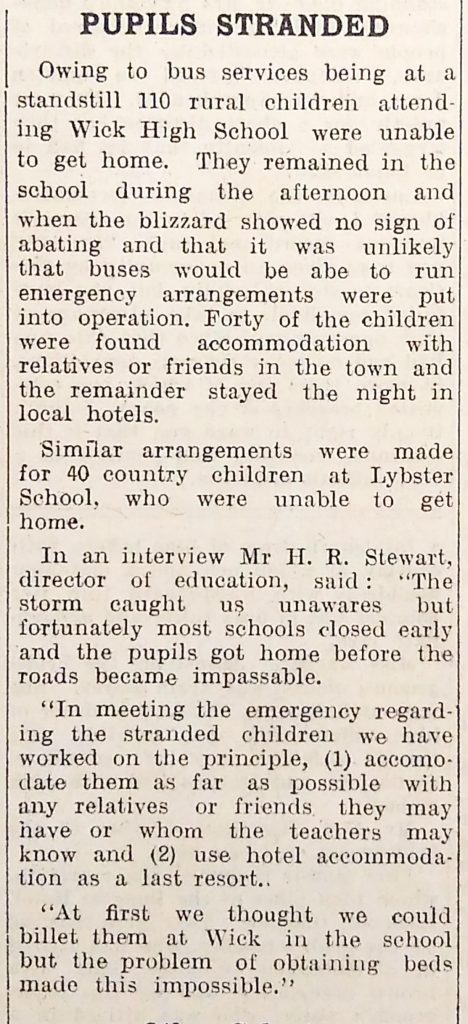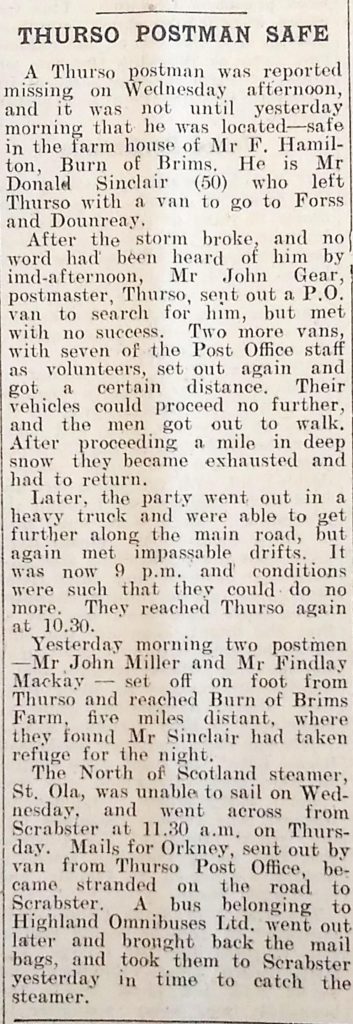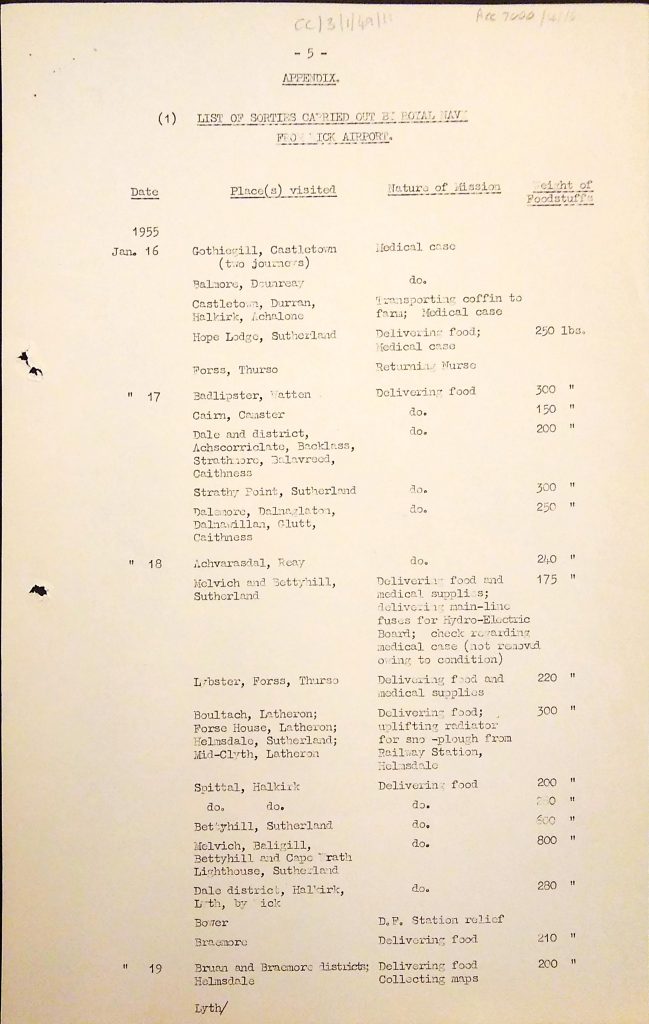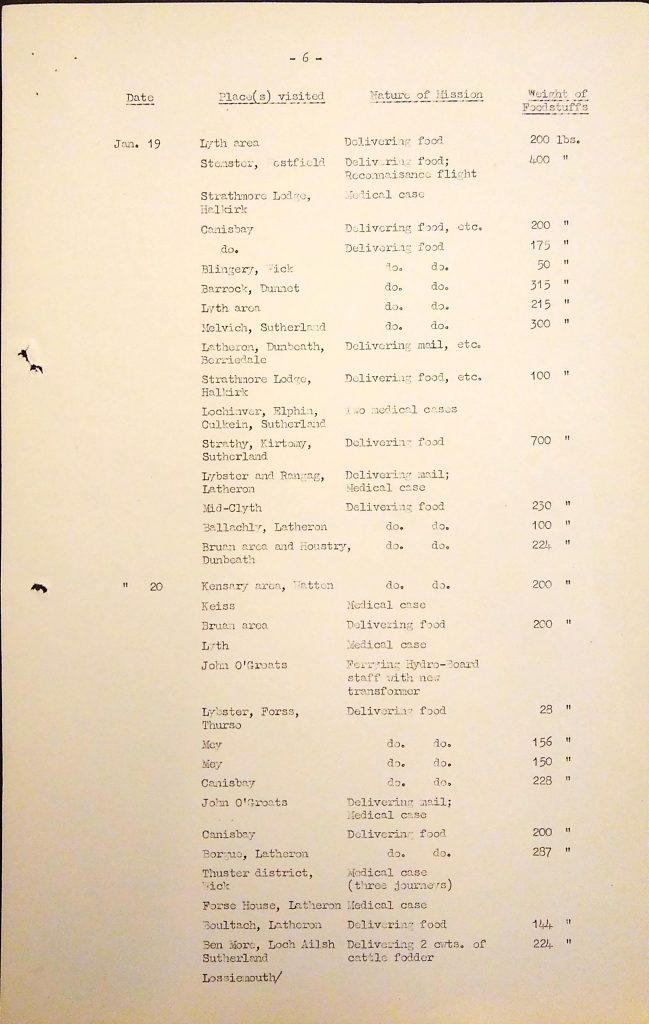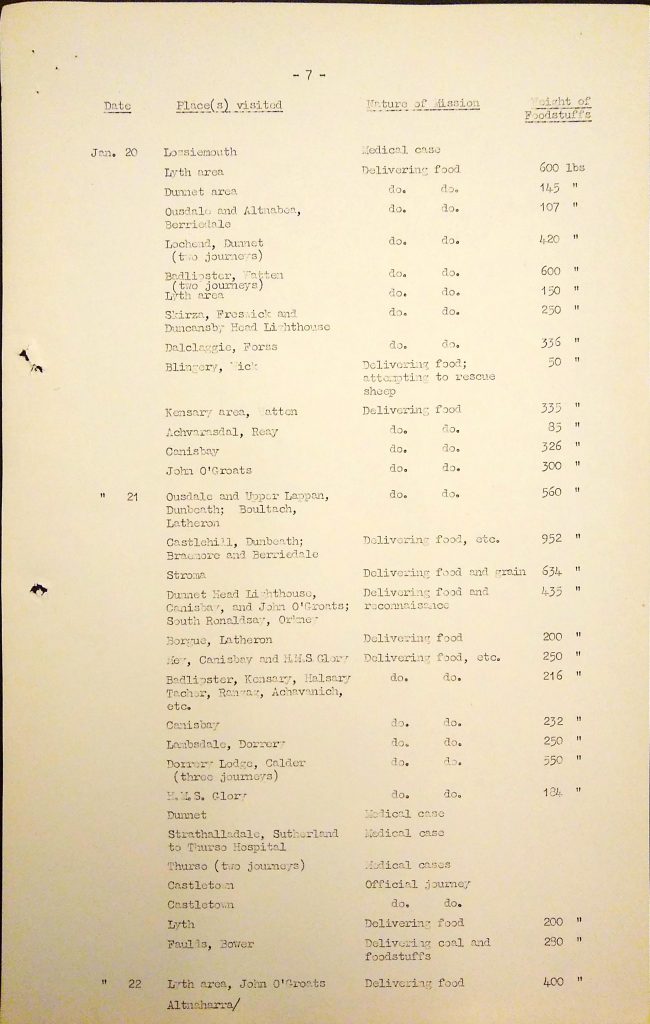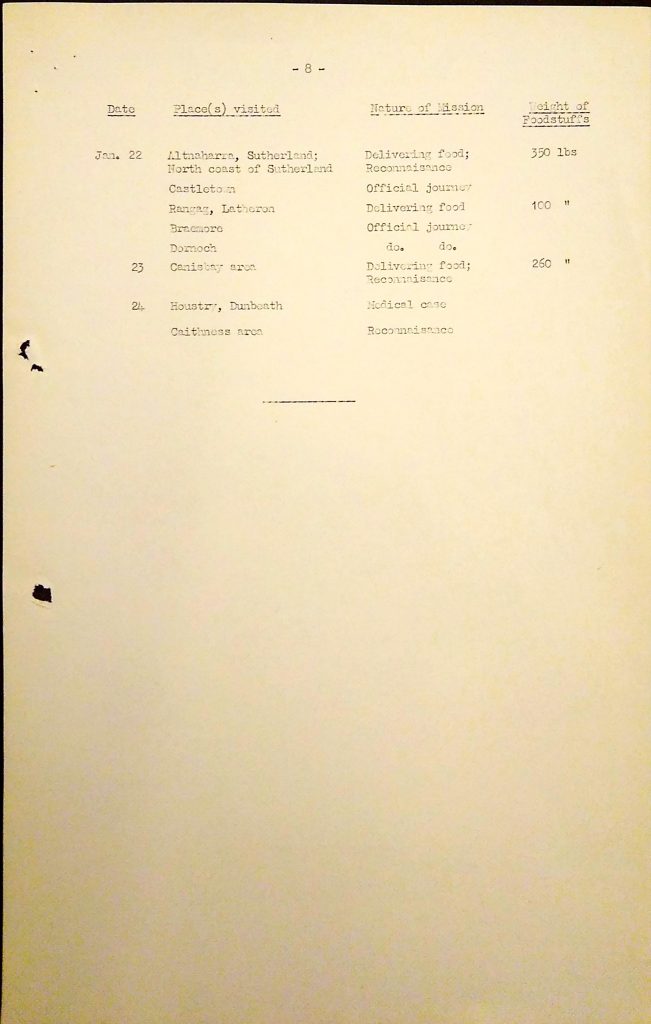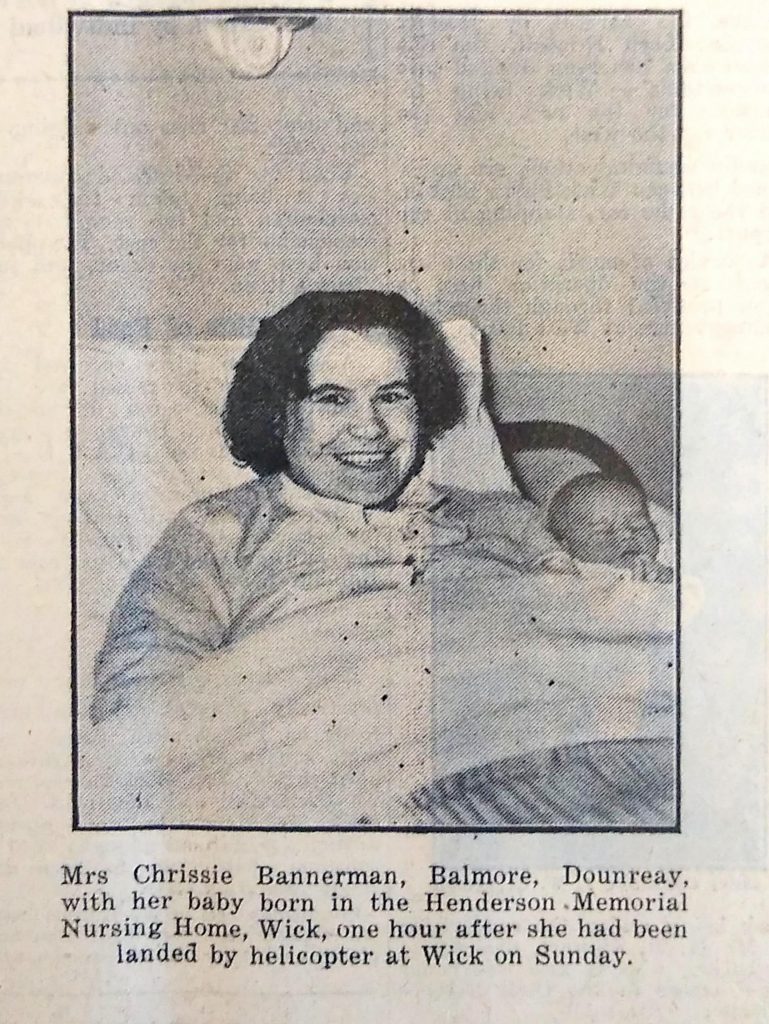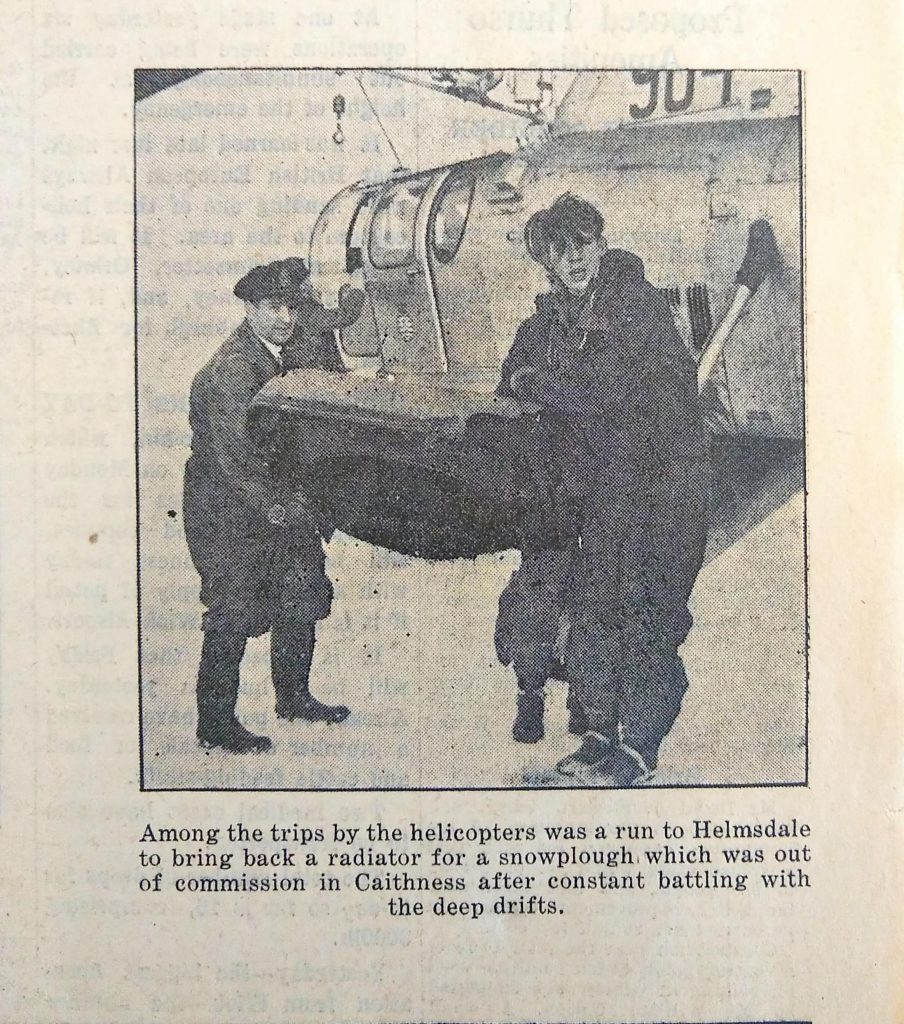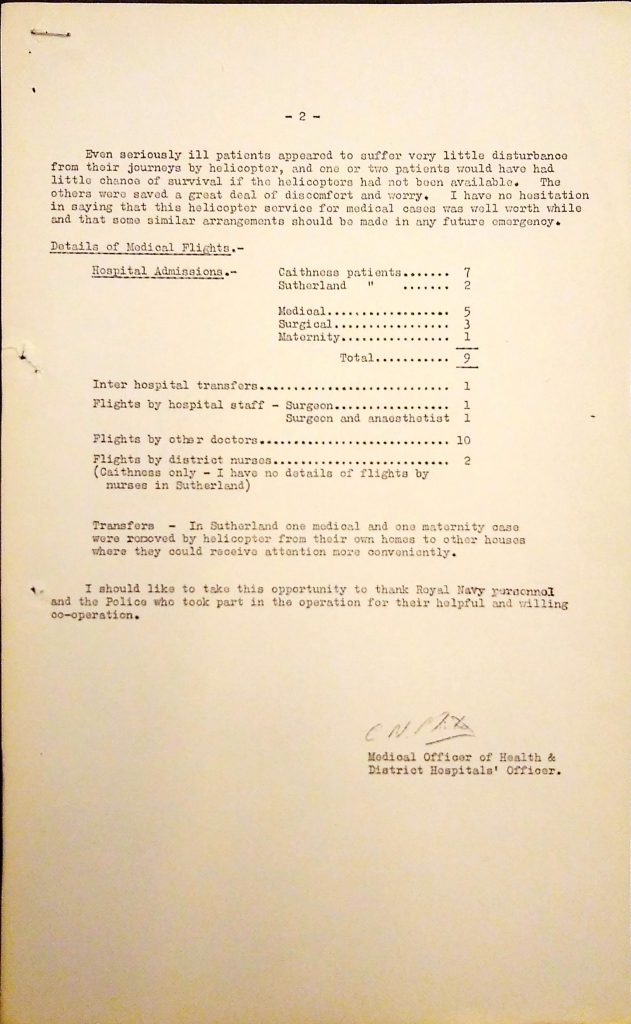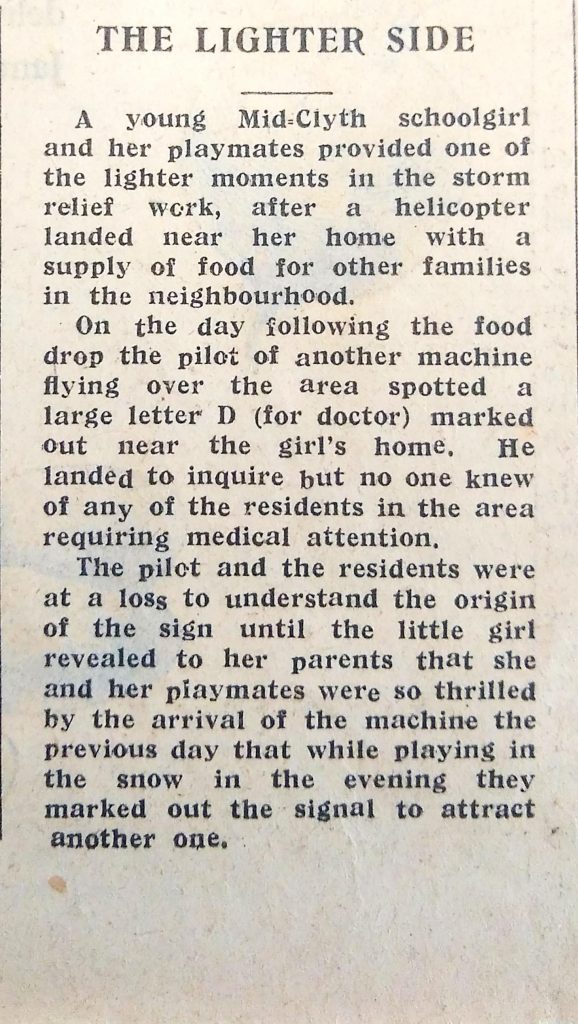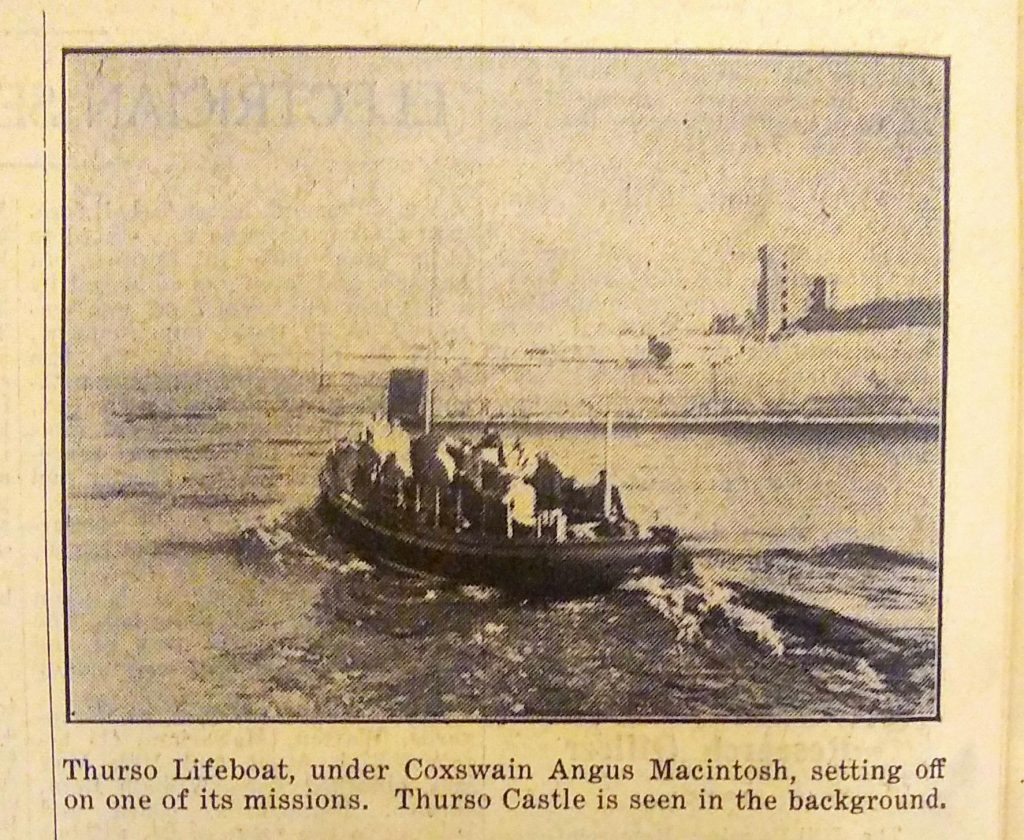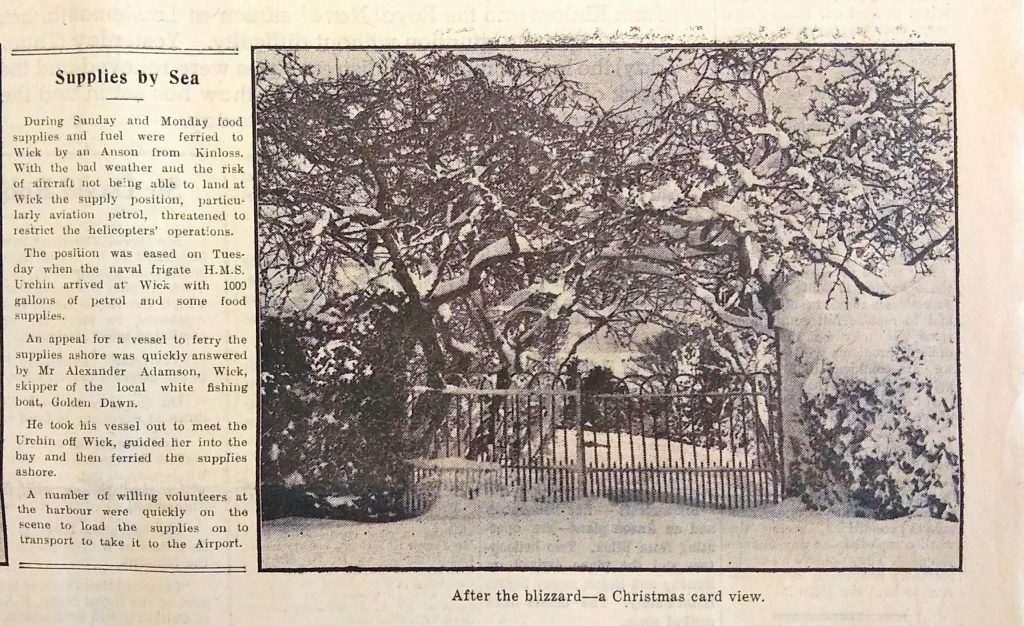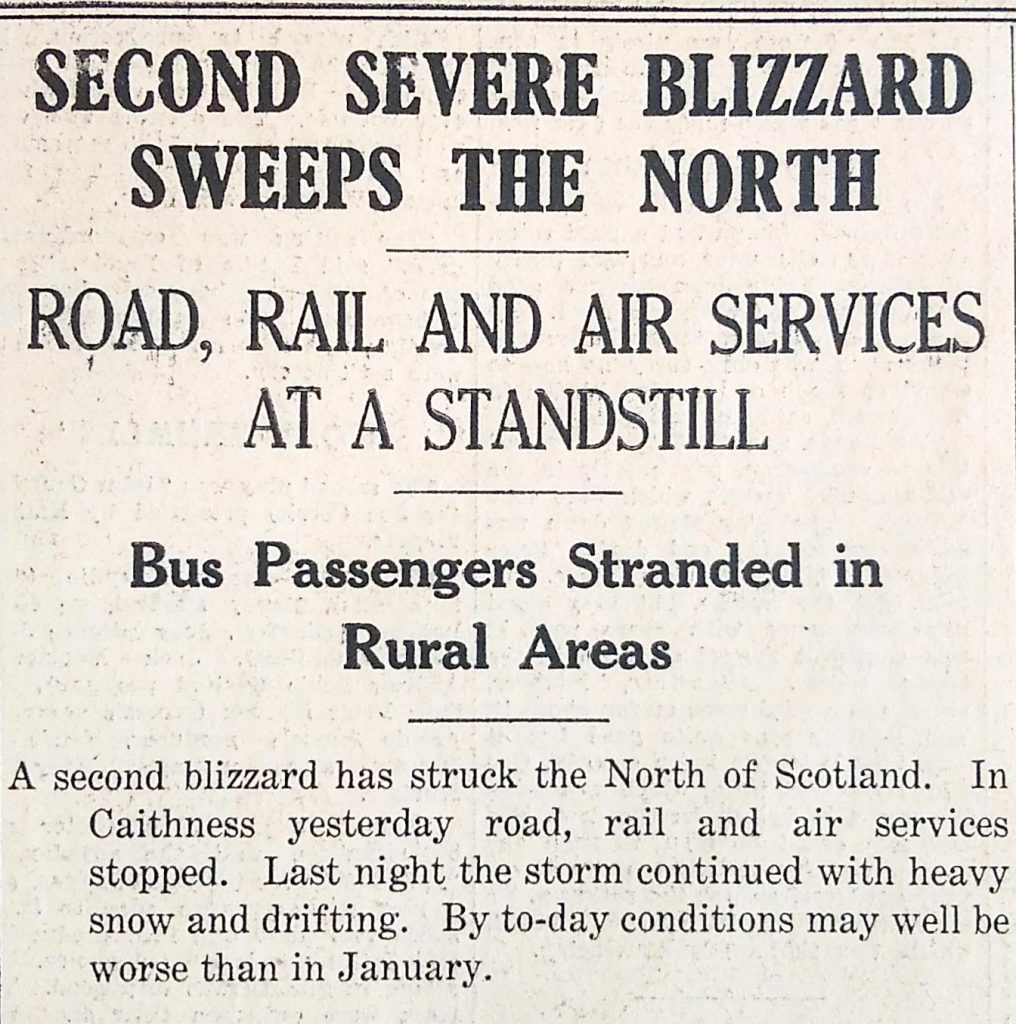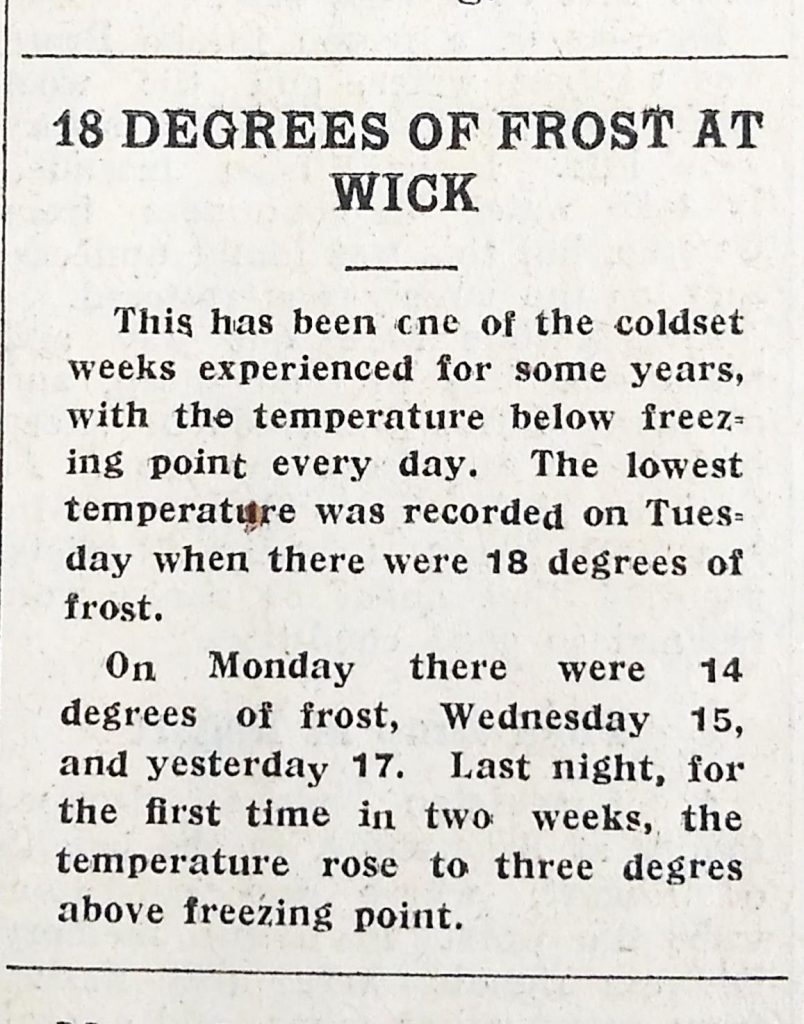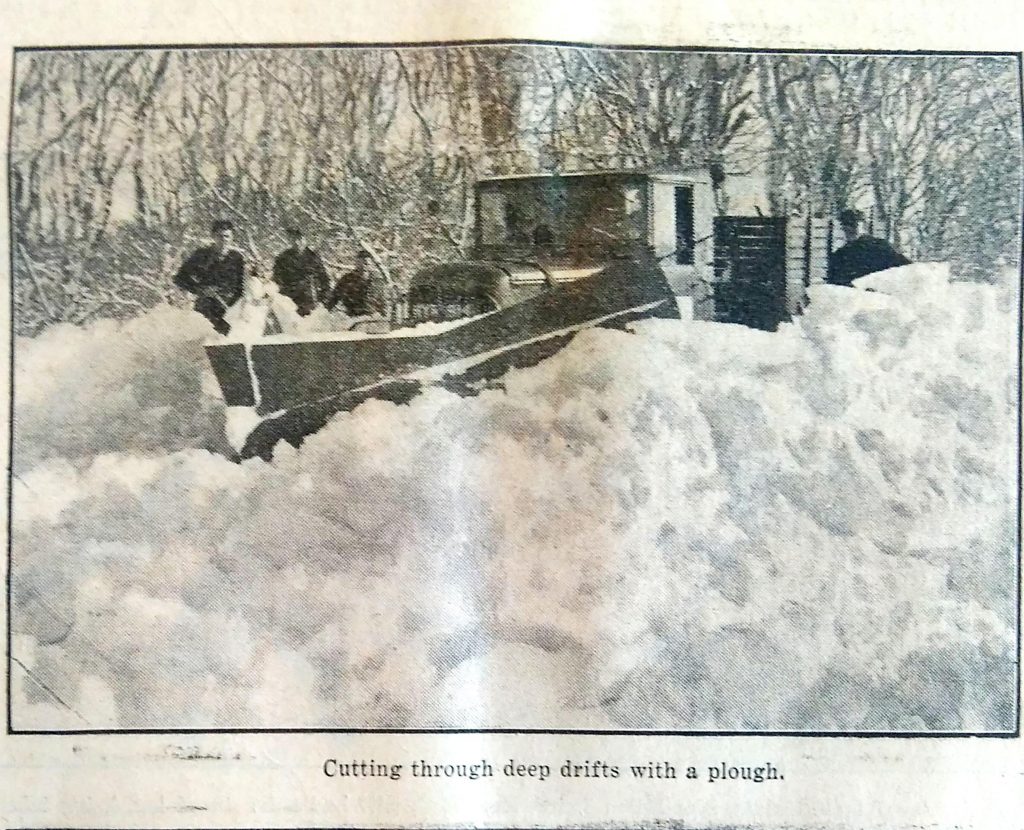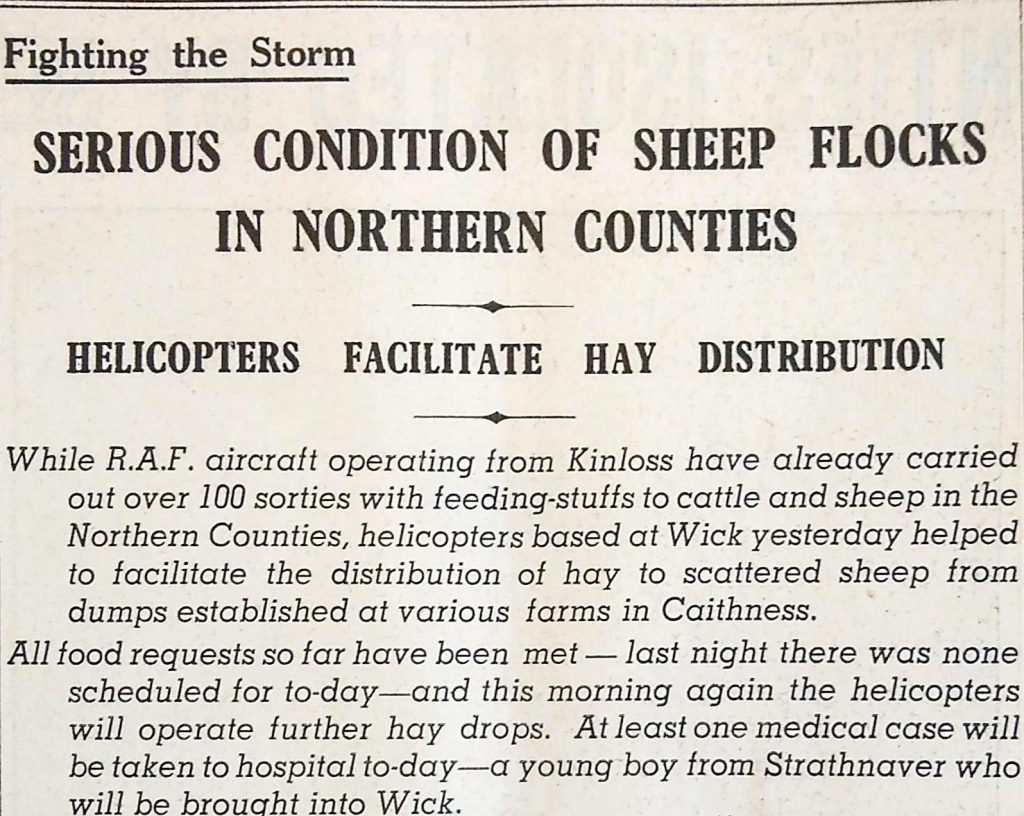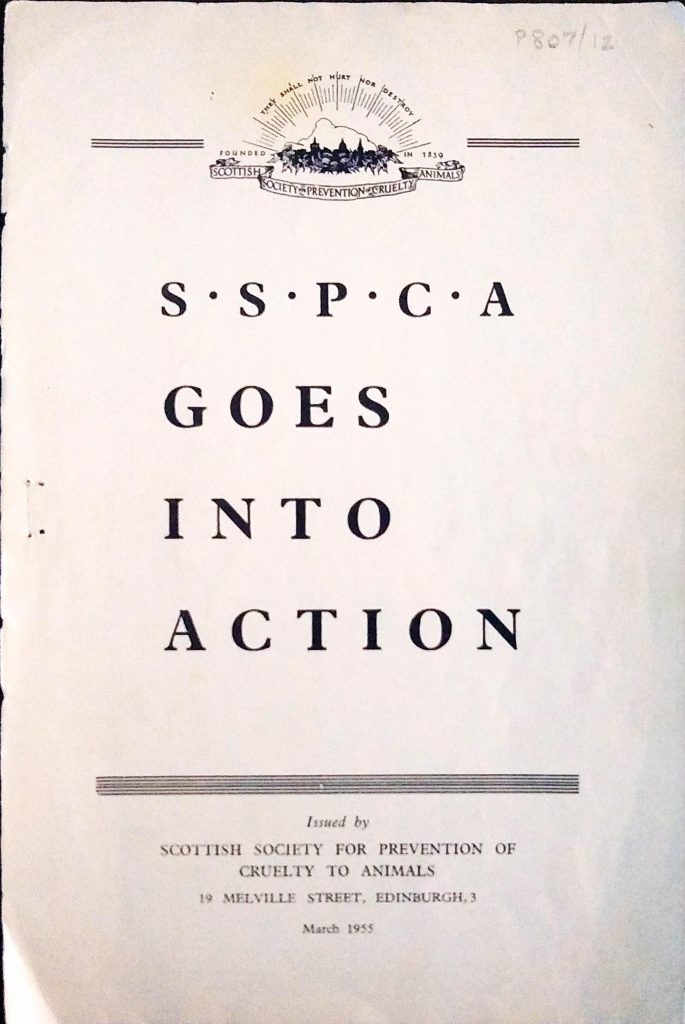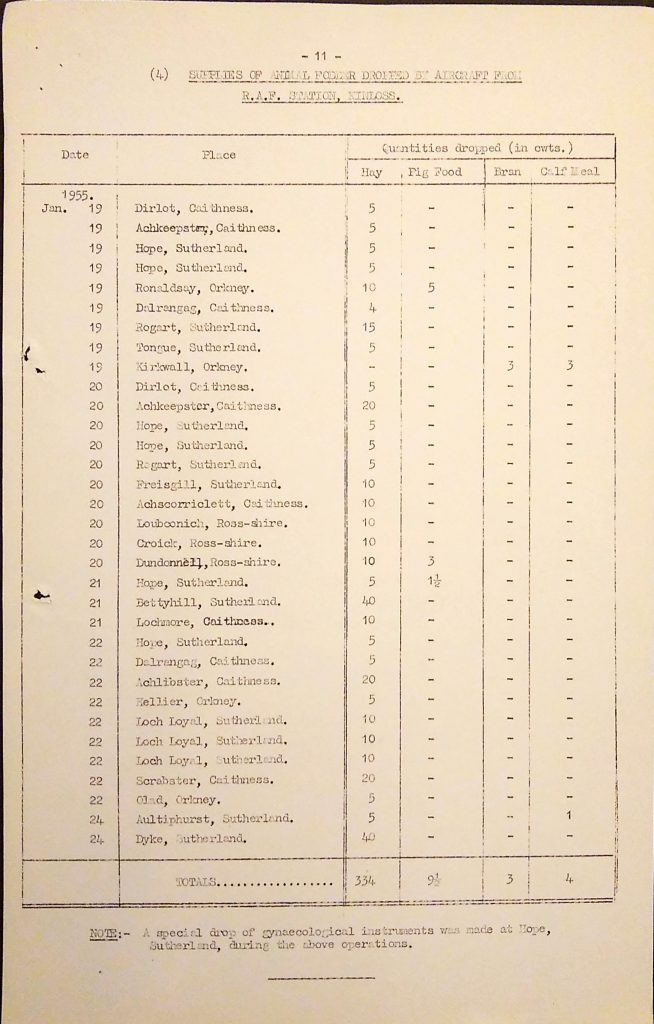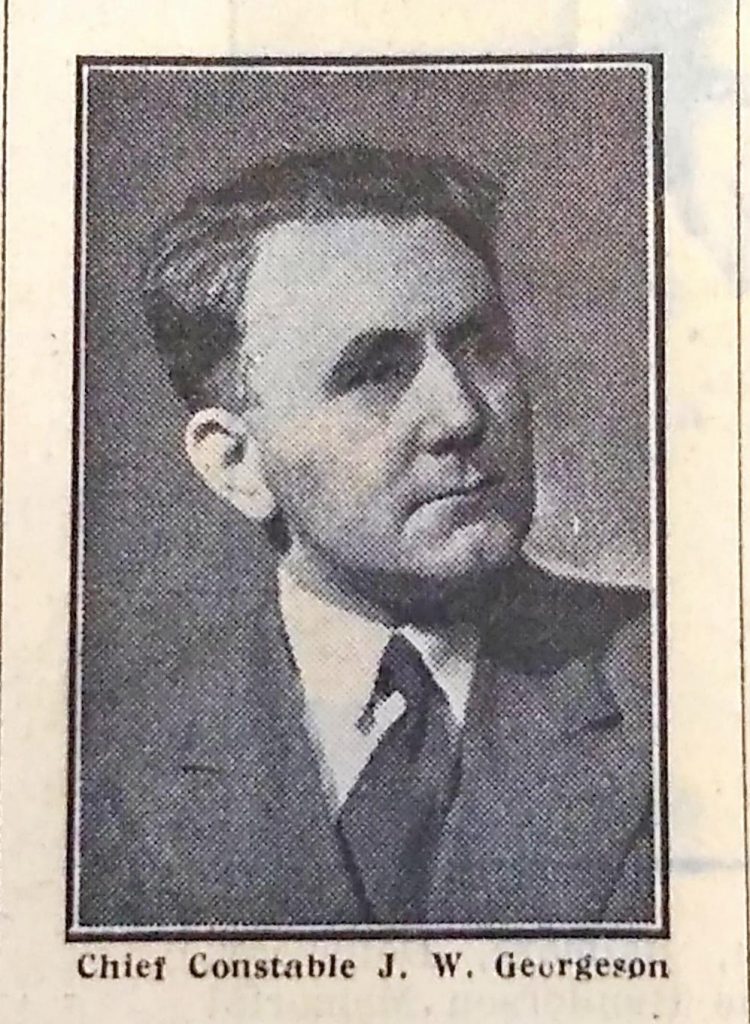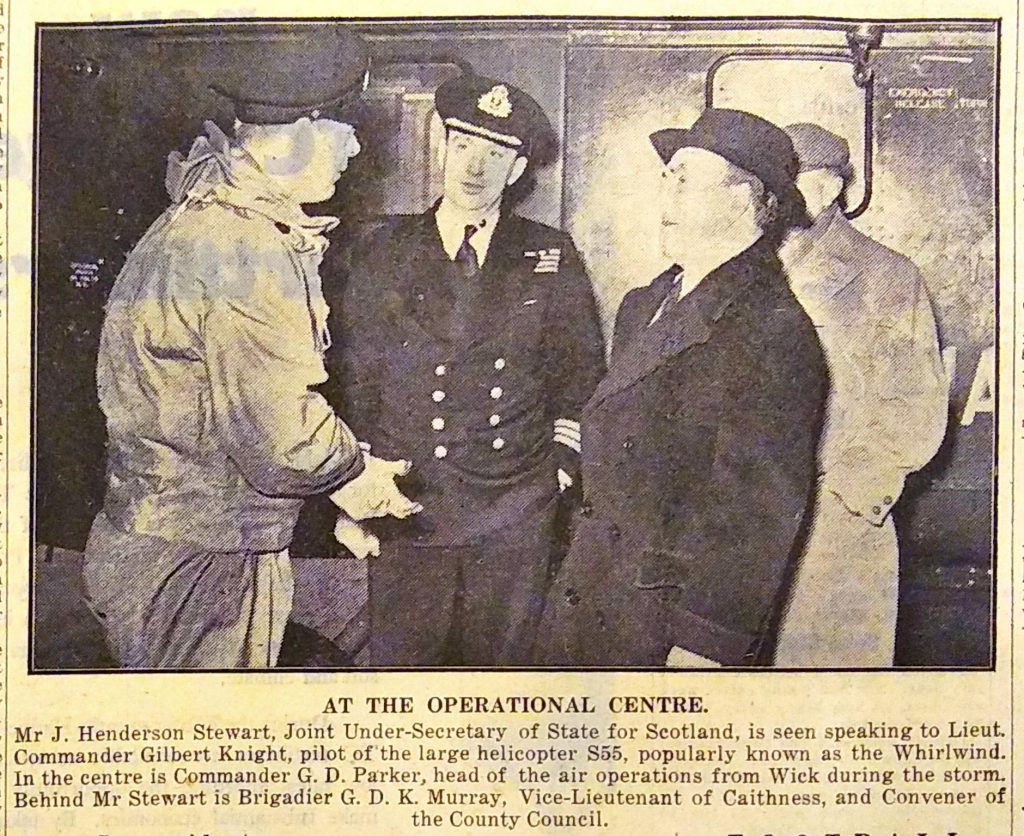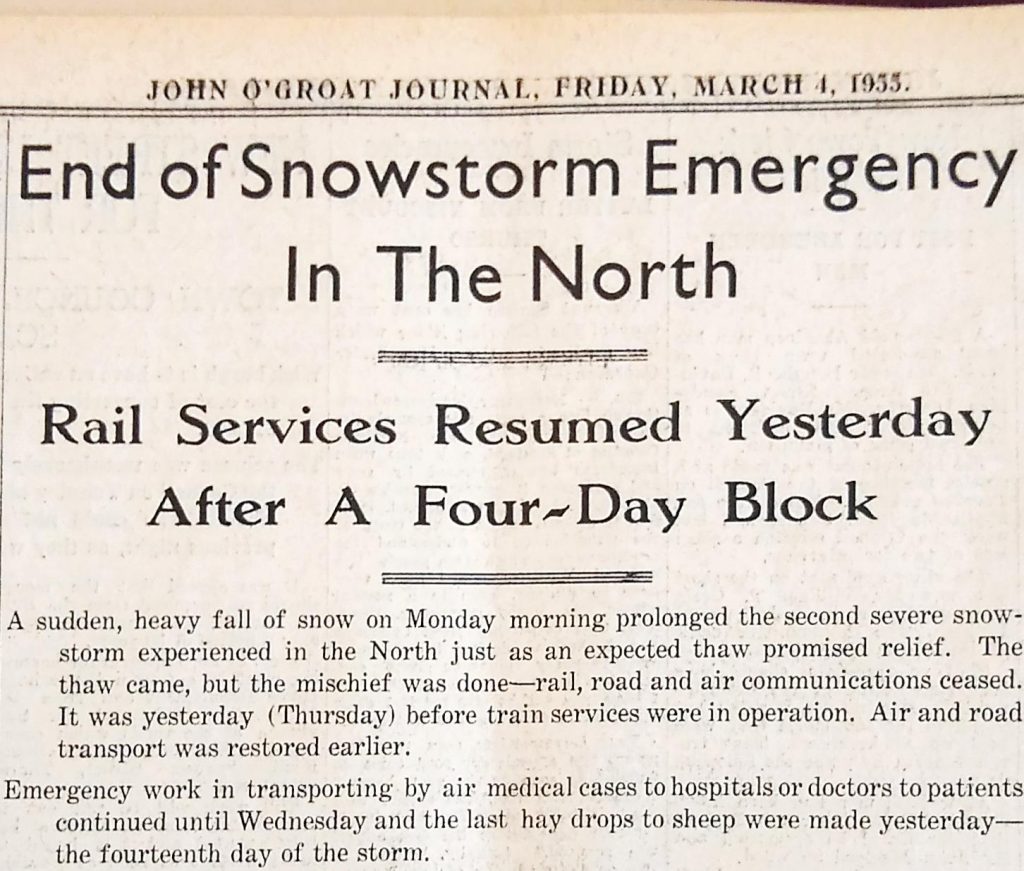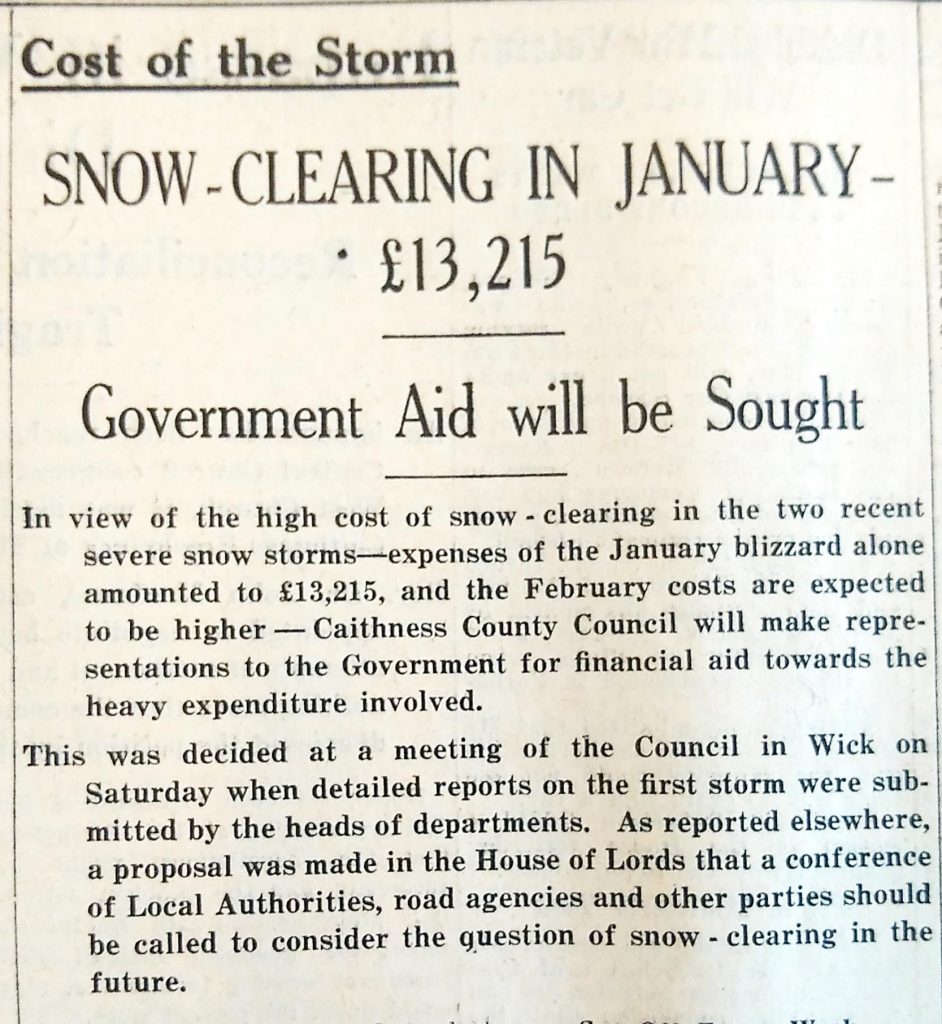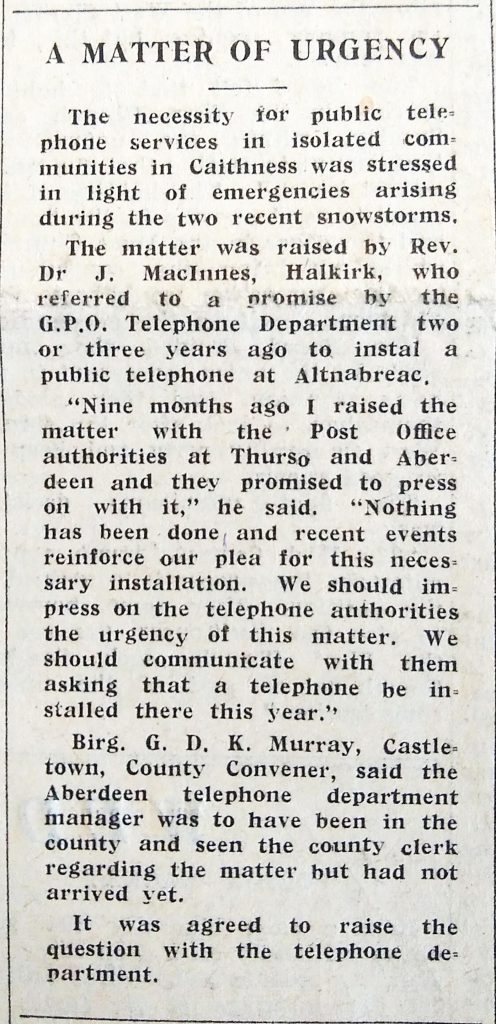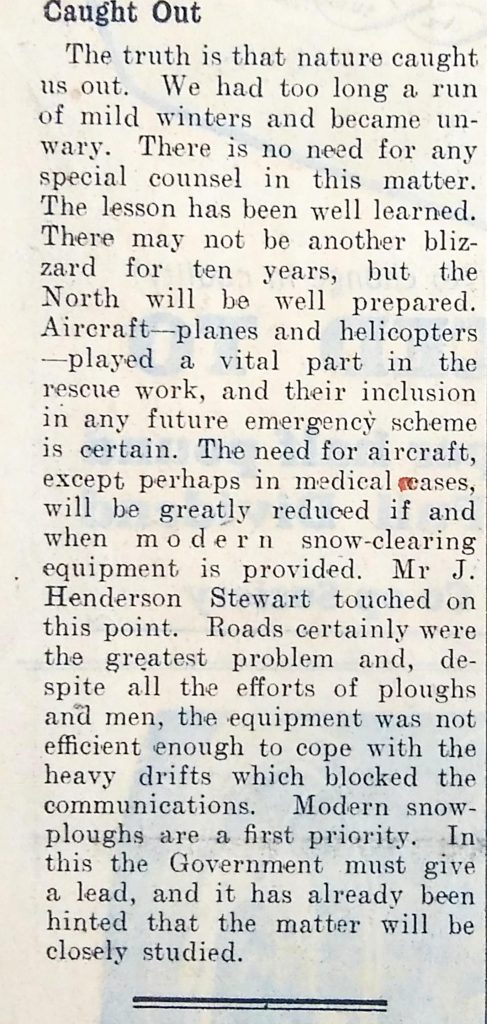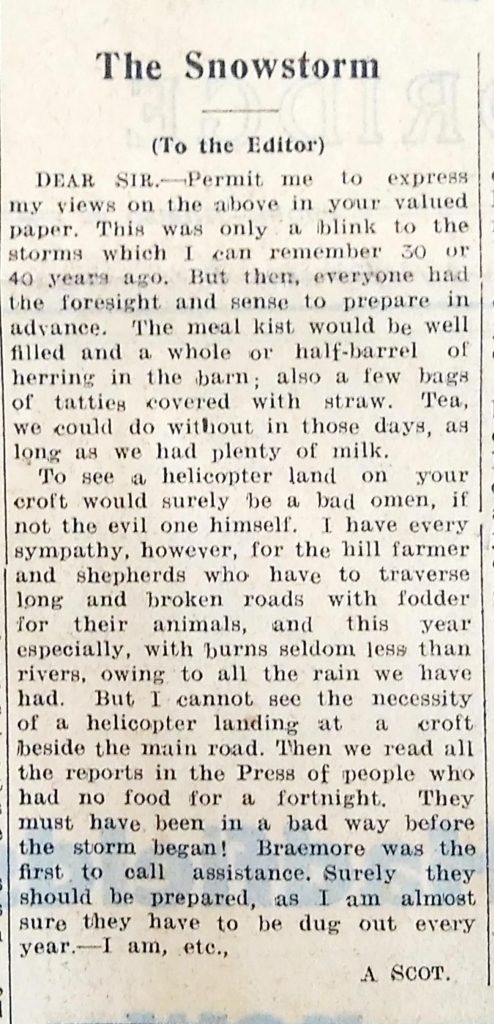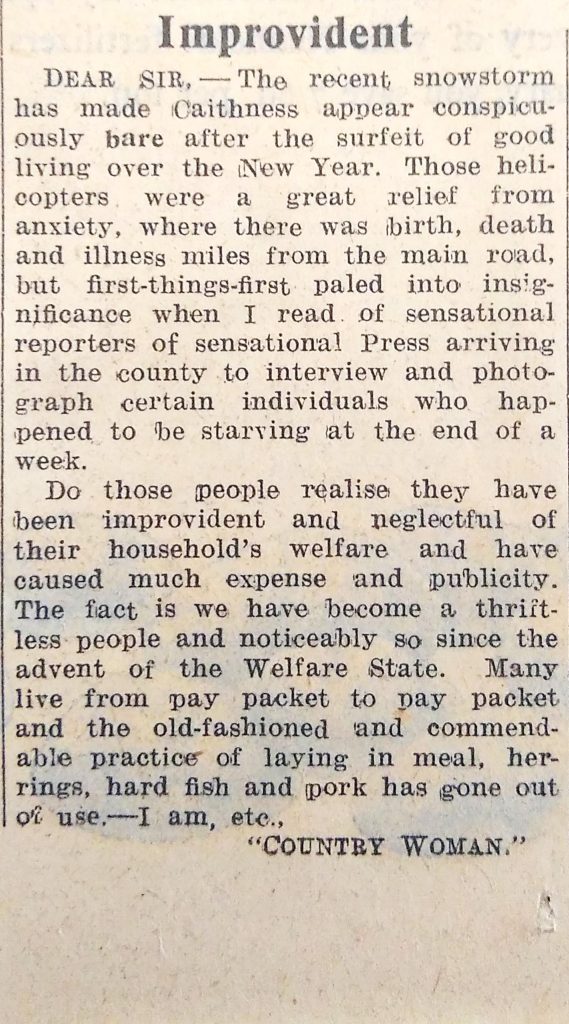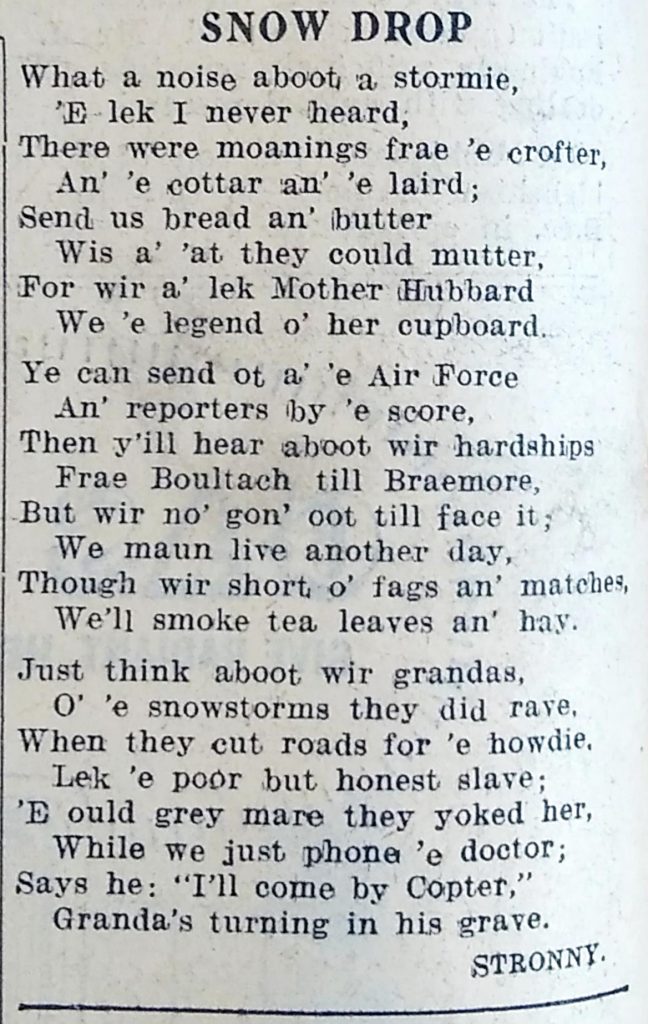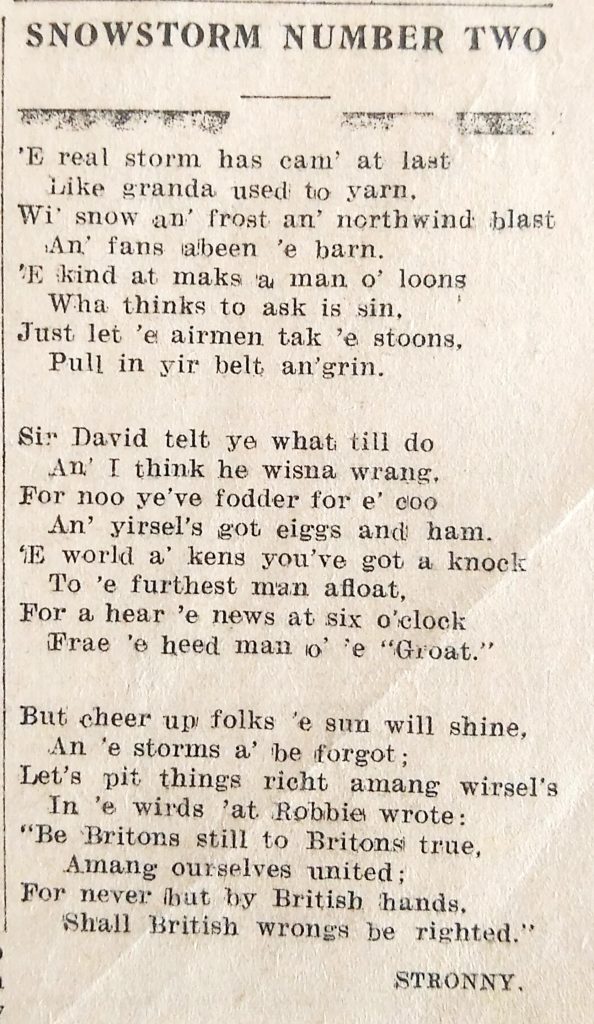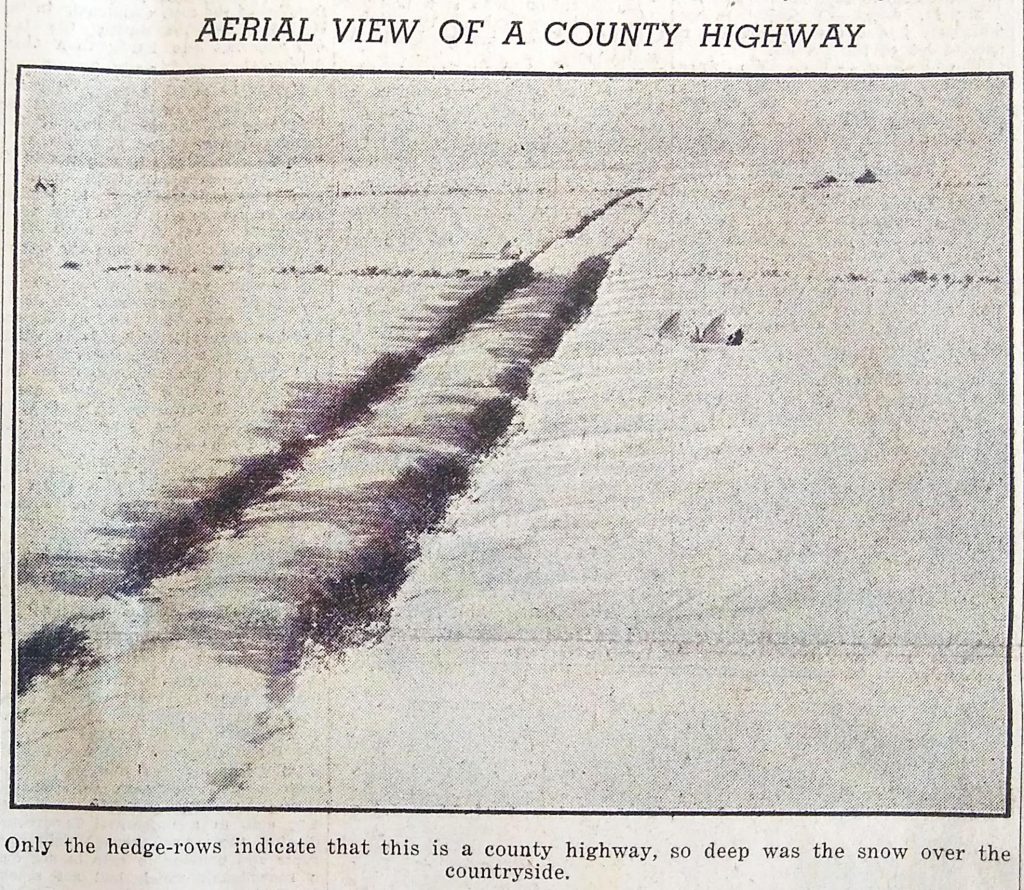
A Brief Introduction
Our focus in this edition of Stories from the Archive will be Operation Snowdrop 1955, an unbelievable exercise in response to emergency across government departments, the armed forces, the police, the health service and throughout the general population.
In January and February of 1955 severe snowstorms caused disruption across the north of Scotland and Caithness was no exception. Many became stranded in rural areas & towns; roads across the county became impassable; trains were caught short between their stations; livestock became isolated amidst snowdrifts; patients were cut off from medical care. These and countless other stories detailing the impact of the weather are found throughout our collections at Nucleus: The Nuclear and Caithness Archives.
What is perhaps even more astonishing is the response of the Royal Navy and Air Force working with officials, the police and the public to provide food, medical care, fodder and resistance to the onslaught of snow and sub-zero temperatures.
We’ll be exploring several of our collections to showcase this enthralling episode in Caithness history.
Authors & Provenance
Delving into several collections helps to inform our stories, giving a multiperspective, layered account of the events with more detail, both textual and visual.
Caithness County Council Minutes & Reports (CC/3/1/49/11)
The records of the county council are invaluable in detailing the response to the snowstorms. We’ll hear from the County Clerk, Police Constable, County Medical Officer and County Roads Surveyor concerning their efforts to curtail the emergency situation. These reports were produced in the weeks following the crisis and offer a comprehensive overview of the action taken. Our Caithness County Council collection covers the years from 1720-1975 and is held as the Caithness series of the unitary Highland Council record. It also includes school and pupil records, valuation rolls and parish records of poor relief.
Sheilton Farm Papers (P807)
This collection includes an S.S.P.C.A. booklet detailing the cooperation between the society’s inspector, the police and the air force in orchestrating the daunting rescue. The collection was deposited privately to the archive and includes family papers and photographs dating from 1858-1955.
The John O’Groat Journal (P953)
The local paper is vital in providing a myriad of anecdotes and local experiences, photographs, opinionated letters and even poems that bring the contemporary confrontation with the snowstorms to life. Nucleus holds annual volumes of the John O’Groat Journal (1836-2018) which were privately deposited as part of an extensive collection including sister paper the Caithness Courier, magazines, periodicals and photographs.
Formats
How do we approach these diverse collections in attempting to understand the events of January and February 1955? It is helpful to think of the diverse formats aggregating to form a more fully formed insight into Operation Snowdrop. The importance of the County Council reports is the accountability with which these records were produced; they were specifically created to document the response, to provide an official record from an administrative body. The minutes and reports of the County Council are a strong foundation from which to build a more colourful understanding of people’s experiences. The stories and reportage of the John O’Groat Journal provides the sought after extra colour, the local opinion and anecdotal flair that the official record so often leaves out. The amazing photography adds a visual element and really takes us back to the event, capturing the times in still shots from the ground (and air!).
January 1955, Snowstorm One
‘The storm started on Monday, 10th January, but it was not until Wednesday that we got a heavy snow fall. The roads all became completely blocked that day. On the following Saturday morning I got the first call for assistance. It was from the inhabitants of Braemore for foodstuffs. They were speaking from a kiosk and stated that they were short of food and asked me what could be done.’ (Report of County Clerk on Emergency arising from Snowstorm – C/3/1/49/11)
These are the words of Caithness County Clerk James Robertson, Esq., writing in January of 1955. The storm, of which there had been warning, was far more severe than anticipated, with blizzards of up to 60mph and temperatures in Wick reaching minus eight. Very quickly, disruption was felt throughout the county.
Many became stranded whether they were passengers arriving at Wick by plane.
Those heading to Inverness by train.
School pupils who could not return home.
Or indeed, the local postman from Thurso.
Eight Caithness ploughs were operating on the roads and three became stranded making clear how hazardous the conditions were. Halkirk became completely isolated from the rest of the county with telephone lines down and all roads blocked. The Dunbar Hospital, Thurso, was cut off from the town for the first two days of the storm. As well as this over thirty ‘stranger’ vessels fishing off the east coast of Caithness rushed to Wick harbour for shelter.
Outwith the built-up areas of the towns, inhabitants of rural communities began in greater number to call for assistance as they ran low on food or sought medical attention. In first assisting Braemore, County Clerk James Robertson contacted the Welfare Officer who put him in touch with Captain R.B. Thomson, Station Commander at R.A.F. Kinloss. He responded at once and agreed to land food stuffs at Braemore. Supplies arrived, amazingly, within two hours of their initial phone call!
Soon thereafter Mr. Robertson received another call from Lieutenant Commander Henley at Lossiemouth, through the Roads Department, stating that he would be glad to help and had two helicopters available for use. The Chief Constable Mr. James William Georgeson was informed of their imminent arrival at Wick and met the Naval personnel at the aerodrome. Inspector Neil Sutherland oversaw Police headquarters where all messages came in. Mr. Robertson continues in his report that:
‘provision of radio telephony at Police Headquarters, Wick, and in the police cars was of inestimable value as it enabled messages for help to be passed from Police Headquarters to the police car stationed at the aerodrome so that there was no delay between receipt of any message and those in charge of the ‘drome.’ (Report of County Clerk on Emergency arising from Snowstorm – C/3/1/49/11)
Within the same County Council files is a report from Chief Constable J.W. Georgeson. The Appendix to his report details the places visited by the helicopters, the nature of each mission and the weight of foodstuffs delivered between the 16th and 22nd of January. The Appendix is reproduced below and reveals the extent, in the Chief Constable’s words, of the ‘special drive to combat ensuing hardships ultimately known as Operation Snowdrop’.
The missions flew across Caithness and Sutherland bringing aid to those who were in need. The John O’Groat Journal affords some extra detail of these flights over the impassable snow-white land.
Those awaiting the arrival of aid would be instructed to mark large letters in the snow to assist the helicopters. A ‘D’ sign would indicate that medical attention was required. Chief Medical Officer for Caithness Dr C.N. Minto reports that:
‘the first patient was carried by helicopter on 16/1/55… the surgeon and anaesthetist were flown from Wick to Thurso to perform an emergency operation… one flight was made by the surgeon in order to treat an elderly patient who refused to fly in the helicopter… medicines were delivered to patients who had run out…’ (Report of County Clerk on Emergency arising from Snowstorm – C/3/1/49/11)
The final page of Dr Minto’s report is shown below detailing the successful nature of these medical missions by air and the number of patients helped across Caithness and Sutherland.
The signaling of aircraft using the ‘D’ sign proved invaluable. It did, nevertheless, lead to some mischief.
Great amounts of provisional assistance became available by air in a remarkably short period of time. However, it was not only by air that aid was delivered to those in need.
Thurso lifeboat took on food supply missions to Sandside and Reay, whilst also delivering a coffin to Portskerra. On their mission to Portskerra on the 16th of January, the County Clerk’s report reveals that they were unable to land owing to stormy weather with urgent medical supplies including insulin being thrown from the lifeboat onto the quay ‘at considerable risk to lifeboat and crew’.
Meanwhile, in Wick, local skippers Alexander Adamson and John Sinclair helped ferry petrol supplies ashore to fuel further helicopter operations.
And well it seemed, after all. By the 28th of January the local papers were reporting the turning of the tide and the waning of the emergency.
Little could it have been known that further and more intense weather was to follow…
February 1955, Snowstorm Two
Thankfully, the second storm came throughout the night meaning that far fewer people became stranded away from home. The weather, however, was arguably worse with blizzards of up to 71mph and snowdrifts in some areas over 10 feet deep. Schools and railways closed once again, and roads became equally impassable.
In this regard, the work of the Roads Department was tireless as the report of County Road Surveyor Cameron Sutherland attests:
‘All the roads in the county became blocked… an extra plough belonging to the Ministry of Transport arrived from Ayrshire, having helped to clear the A9 on its way North… the digger was used on a block at the Burn of Brims, Forss measuring over 12 ½ feet… more than 1,000 incoming calls were being dealt with during the storm… I would like to put on record the great assistance I received from telephone subscribers throughout the County who readily gave me information regarding the conditions in their area and information as to the whereabouts of the snowploughs… the Council may wish to consider at this stage whether it be advisable to install two-way radio sets in at least some of the ploughs.’ (Report of County Clerk on Emergency arising from Snowstorm – C/3/1/49/11)
Comparing these machines to the snowploughs of today gives some idea of the task presented to those working to clear the roads.
Hardships were felt all across the communities of Caithness, most readily in rural areas. Aid missions to the countryside were not, however, only sent for the people caught in unbearably freezing conditions.
This was the first time that the assistance of the Royal Navy or Royal Air Force had been enlisted in dropping fodder to cattle and sheep. Alexander Dickson, the S.S.P.C.A.’s Inspector for Caithness, was called upon to help rescue sheep, often left in a very weak condition by the storms. The helicopters could carry five sheep.
Many astonishing photographs featured within a short S.S.P.C.A. booklet released in March 1955, which is held within our collections.
A second Appendix from the County Clerk’s report below highlights the magnitude of fodder dropped across the county, and beyond, to aid the bewildered animals.
The success of so many missions over air, sea and land, organised and dispatched in such a short period of time, before mobile phones, or internet connections, is a testament to the ingenuity displayed throughout Operation Snowdrop and to those involved.
And so with the end of February Caithness saw the end of the dreadful weather that had affected so many.
Costs, Lessons & Opinions
Operation Snowdrop was undoubtedly a success in aiding those left stranded without food or medical supplies throughout two extremely fierce snowstorms. Much distress and tragedy was nonetheless endured.
The impact of the storm was costly, both financially and otherwise, and the response was a vital lesson in how cooperative branches of government, the armed forces, and the general public could come together and resist as a community. As Caithness looked to the future the ‘cost of the storm’ was considered.
Warnings of the possibility of another such storm were taken seriously and certain necessities were addressed.
Appreciation of the efforts of all involved pours from the pages of the Council reports and commendations for risks taken to deliver assistance and aid are conveyed throughout editions of the John O’Groat Journal. There is to be found amongst the high praise, nevertheless, voices of dissent railing against another chosen culprit they believe responsible for the intensity of the storm’s impact: improvidence & modern life.
We hear above from an older generation who recall the ‘Great Freeze’ of 1895 & 1917 and are in many ways at a loss to understand the difficulties faced in 1955. It is perhaps a reflection of a more centralised country, a loss of the self-contained rural life that once ensured the need for preparedness. It seems that in a more connected world we in some ways open ourselves to more vulnerabilities; a sentiment quite potent amidst our current global crisis.
One Caithness resident, instead of pointing blame, decided to react creatively to the situation, addressing the circumstances with imagination and asking for strength and an optimism to help everyone through.
Afterword
There are many wonderful stories held within the archives relating to Operation Snowdrop, so many that we could only share a few with you today. The impact of such an event is revealed through its evidence of joint responsibility and action, one that recurs often in the face of natural crisis, war & pandemics.
Lessons from the past, a sense of shared humanity, and the small gap between then and now are always very close by when exploring the collections at Nucleus.
We hope you enjoyed another edition of Stories From The Archive. Please send your feedback and comments through our Facebook page.
https://www.facebook.com/nucleuscaithnessarchive/
